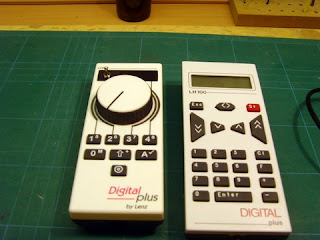
Other work completed on 'Niddbeck Bridge' this week has seen final hooking-up of the'XpressNet' around the layout. This allows you to roam with a handheld throttle and plug-in where ever an outlet facia is located. I have 2 on the rear and one on the front.
Each LA152 facia panel has 3 outlet sockets (2 x DIN type, 1 x phone type). This has allowed me to have both my Lenz handsets working concurrently for the first time. The handset on the left is an LH90 with knob control and LED display and the righthand one is a LH100 with full keypad and LCD display.
Why would I want two handsets you might ask? Both have their good points and bad points and my opinion is that ownership of both is a good idea. The LH100 with its full keypad and better display is great for decoder programming and setting up things generally. On the downside I find the button speed controls not as easy to use as a rotary knob and it only has a loco memory stack of 2 addresses.
The LH90 is an ideal driving and operating throttle but less easy to program with due to the lack of a full keypad. With the large rotary knob and traditional toggle reversing switch I find it easier to drive trains without having to look at the throttle, something I find I often have to do with the LH100. The LH90 also has a loco memory stack of 8 addresses which is much better. When in accessory switching mode, the '2' & '3' buttons allow you to scroll up and down the accessory list adresses (ie points, signals and uncouplers) and the '1' and '4' buttons act as the -/+ switches. Whilst in accessory switching mode the last loco called up remains under full control of the knob and toggle switch, so is an ideal arrangement for shunting.
Another option is to use the LH90 as my loco cab and the LH100 as my signal box. Great fun this DCC business!
Another afterthought has been the addition of a isolated 200mm length of programming track on the fiddle yard, as I thought this might be useful at exhibitions. Prog tracks allow decoder installations to be 'read' and tested at lower power and will avoid a blown decoder if an incorrectly wired or badly insulated loco is subject to full DCC power. It is also safer the change decoder CV settings on an isolated programming track. It can be done 'on the main' but you risk changing settings on other locos if you make a mistake!
Apart from a layout stand and a lighting rig I must now turn my attention to architectural and scenic development of the layout, or proper modelling as no doubt many of you will think!
Edward
Each LA152 facia panel has 3 outlet sockets (2 x DIN type, 1 x phone type). This has allowed me to have both my Lenz handsets working concurrently for the first time. The handset on the left is an LH90 with knob control and LED display and the righthand one is a LH100 with full keypad and LCD display.
Why would I want two handsets you might ask? Both have their good points and bad points and my opinion is that ownership of both is a good idea. The LH100 with its full keypad and better display is great for decoder programming and setting up things generally. On the downside I find the button speed controls not as easy to use as a rotary knob and it only has a loco memory stack of 2 addresses.
The LH90 is an ideal driving and operating throttle but less easy to program with due to the lack of a full keypad. With the large rotary knob and traditional toggle reversing switch I find it easier to drive trains without having to look at the throttle, something I find I often have to do with the LH100. The LH90 also has a loco memory stack of 8 addresses which is much better. When in accessory switching mode, the '2' & '3' buttons allow you to scroll up and down the accessory list adresses (ie points, signals and uncouplers) and the '1' and '4' buttons act as the -/+ switches. Whilst in accessory switching mode the last loco called up remains under full control of the knob and toggle switch, so is an ideal arrangement for shunting.
Another option is to use the LH90 as my loco cab and the LH100 as my signal box. Great fun this DCC business!
Another afterthought has been the addition of a isolated 200mm length of programming track on the fiddle yard, as I thought this might be useful at exhibitions. Prog tracks allow decoder installations to be 'read' and tested at lower power and will avoid a blown decoder if an incorrectly wired or badly insulated loco is subject to full DCC power. It is also safer the change decoder CV settings on an isolated programming track. It can be done 'on the main' but you risk changing settings on other locos if you make a mistake!
Apart from a layout stand and a lighting rig I must now turn my attention to architectural and scenic development of the layout, or proper modelling as no doubt many of you will think!
Edward

No comments:
Post a Comment